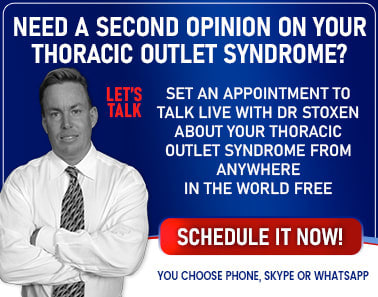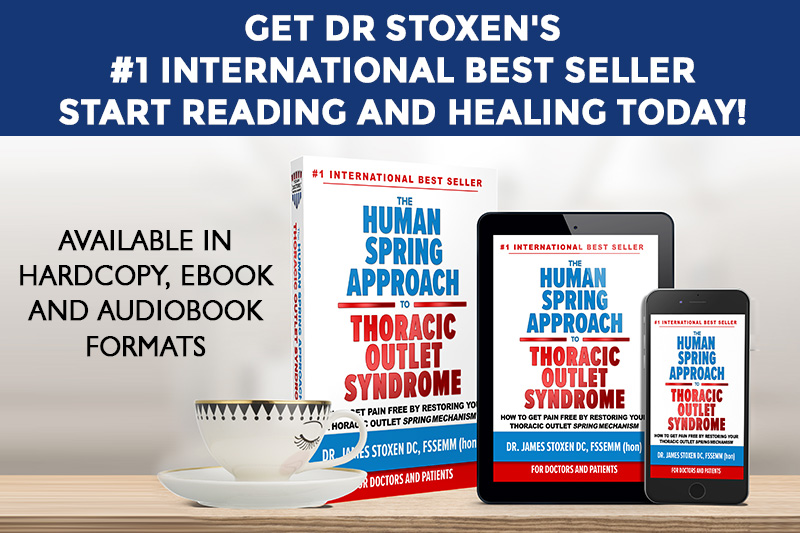If you suspect you have thoracic outlet syndrome you can get this relatively inexpensive tool to painlessly monitor your pulse rate.
If the thoracic outlet is narrowed the subclavian artery can get compressed and either decrease the pulse strength or the pulse can disappear. This is immediately followed by the patient complaining of numbness or tingling in the arm and hand.
One of my favorite orthopedic tests to check for narrowing of the thoracic outlet effecting the subclacvian artery is the Adsons Test. These photos are taken directly from my book, The Human Spring Approach to Thoracic Outlet Syndrome.

I have developed a very fine sense of touch that allows me to determine when the pulse stops. It takes time for doctors to get the tactile sense to be able to feel the pulse.
A non healthcare professional can snap on a pulse oximeter to the finger in just seconds determine the pulse rate or if the blood flow has been stopped by the narrowing of the compressed thoracic outlet.
If you cannot get to a doctor or if your doctor forgets to do this important test you can follow the instructions above and do it yourself. It would be difficult if not impossible to monitor your right pulse with your left hand but if you have the pulse oximeter you can determine if your pulse has stopped with ease.
The pulse oximeter shows immediately when the pulse stops, which provides a more objective finding. I would recommend everyone have a pulse oximeter at home. They are inexpensive and useful to determine heart rate. Of course, you probably have one already on your fitness watch.
I am using my fingers to check the pulse. When you attach the pulse oximeter to the finger tip you can get a more accurate reading. Also you, the patient, can wear this device on your finger at the times and in specific positions when you feel your arm is most likely to go numb or cold.

This method might be a useful, noninvasive, rapid, and inexpensive clinical tool in the diagnosis of thoracic outlet syndrome to provide an objective finding that can diagnose the narrowing of the artery. You can get a pulse oximeter for anywhere between $20 and $1,500. I’ve used $20 oximeters and $250 oximeters and they both tested the same.
This is an excerpt from a chapter in Dr Stoxen’s #1 best seller The Human Spring Approach to Thoracic Outlet Syndrome. The book is available on Amazon.com in these 13 counties US UK DE FR ES IT NL JP BR CA MX AU IN on Kindle. The book is available on Amazon.com in these 7 counties US UK DE FR ES IT JP in paperback.


Dr James Stoxen DC., FSSEMM (hon) He is the president of Team Doctors®, Treatment and Training Center Chicago, one of the most recognized treatment centers in the world.
Dr Stoxen is a #1 International Bestselling Author of the book, The Human Spring Approach to Thoracic Outlet Syndrome. He has lectured at more than 20 medical conferences on his Human Spring Approach to Thoracic Outlet Syndrome and asked to publish his research on this approach to treating thoracic outlet syndrome in over 30 peer review medical journals.
He has been asked to submit his other research on the human spring approach to treatment, training and prevention in over 150 peer review medical journals. He serves as the Editor-in-Chief, Journal of Orthopedic Science and Research, Executive Editor or the Journal of Trauma and Acute Care, Chief Editor, Advances in Orthopedics and Sports Medicine Journal and editorial board for over 35 peer review medical journals.
He is a much sought-after speaker. He has given over 1000 live presentations and lectured at over 70 medical conferences to over 50,000 doctors in more than 20 countries. He has been invited to speak at over 300 medical conferences which includes invitations as the keynote speaker at over 50 medical conferences.
After his groundbreaking lecture on the Integrated Spring-Mass Model at the World Congress of Sports and Exercise Medicine he was presented with an Honorary Fellowship Award by a member of the royal family, the Sultan of Pahang, for his distinguished research and contributions to the advancement of Sports and Exercise Medicine on an International level. He was inducted into the National Fitness Hall of Fame in 2008 and the Personal Trainers Hall of Fame in 2012.
Dr Stoxen has a big reputation in the entertainment industry working as a doctor for over 150 tours of elite entertainers, caring for over 1000 top celebrity entertainers and their handlers. Anthony Field or the popular children’s entertainment group, The Wiggles, wrote a book, How I Got My Wiggle Back detailing his struggles with chronic pain and clinical depression he struggled with for years. Dr Stoxen is proud to be able to assist him.
Full Bio) Dr Stoxen can be reached directly at teamdoctors@aol.com
























